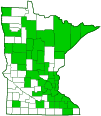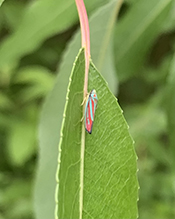red-banded leafhopper
(Graphocephala coccinea)
Conservation • Description • Habitat • Ecology • Distribution • Taxonomy
|
|
||||||||||||||
Description |
With about 19,500 species described, leafhoppers (Cicadellidae) is by far the largest family of true bugs (Hemiptera). There are about 2,500 leafhopper species in North America. Among the largest and most brightly colorful of these are the subfamily sharpshooters (Cicadellinae). One of the most common of the latter is the red-banded leafhopper. It occurs in the eastern United States and adjacent Canadian provinces. It is found in meadows, woodlands, and gardens on the leaves of a wide variety of plants. Red-banded leafhopper, and several other leafhopper species, are vectors of Pierce’s disease caused by the bacteria Xylella fastidiosa, which causes decline of woody plant species. Females are ¼″ to 5 ⁄16″ (7.2 to 8.4 mm) long, males a little smaller, ¼″ (6.6 to 7.6 mm) long. The body is flattened laterally and tapered. From above they appear wedge-shaped. It is brightly colored with red stripes on a blue, turquoise, or green background (called green below). The head is angular, pointed, flattened above, and yellow, with a narrow black band on the outer margin. There are two large compound eyes and two tiny simple eyes (ocelli). There are no longitudinal black lines between the eyes. The antennae are short and bristle-like. They are inserted on the head between the eyes. The exoskeletal plate covering the thorax (pronotum) does not extend over the abdomen. It is green with an yellow submarginal band near the head. A large red spot on each side merges with the submarginal band. The plate between the wing bases (scutellum) is large, triangular, and red or yellow. There are two pairs of wings, and they are held tent-like, almost vertically over the body when at rest. The forewings (hemelytra) are thickened, are longer than the body, and completely cover the sides of the body. On the female, the ovipositor extends beyond the wing bases. The wings are comprised of a narrow area (clavus) behind the scutellum when the hemelytra are closed; and the remaining, broad, marginal area (corium). They are green with three red stripes, an inner stripe on the clavus and a middle and outer stripe on the corium. The inner stripe extends along the outer margin of the clavus. When the hemelytra are closed the inner stripes of both hemelytra join to form a deep V. The middle and outer stripes extend from the base to the tip of the corium. They merge at each end creating an enclosed green area. The red stripes are broad and the hemelytra are usually mostly red. There is also a narrow black band around each blunt wingtip. There is no Y-vein in the anal area. The hindwings are thin, membranous, a little shorter than the hemelytra, and concealed beneath the hemelytra. The legs are yellow. The fourth segment (tibia) of each hind leg has two rows of comb-like spines. The last part of the leg (tarsus), corresponding to a foot, has three segments. |
Size |
Male: ¼″ (6.6 to 7.6 mm) Female: ¼″ to 5 ⁄16″ (7.2 to 8.4 mm) |
Similar Species |
Habitat |
Meadows, woodlands, and gardens |
Ecology |
Season |
Late June to early October |
Behavior |
Nymphs feed on the underside of leaves. Adults are agile and can move as fast sideways as forward. They can jump to avoid predators or move to another plant. |
Life Cycle |
The female lays eggs in the leaves of host plants. The eggs appear as small swellings or bumps on the leaf. Eggs overwinter and hatch in the spring. Nymphs pass through five stages (instars) before emerging as adults. |
Nymph Food |
Same as adult |
Adult Food |
Sap of more than 50 species of plants |
Distribution |
||
|
Sources Biodiversity occurrence data published by: Minnesota Biodiversity Atlas (accessed through the Minnesota Biodiversity Atlas Portal, bellatlas.umn.edu, 7/25/2025). |
|
| 7/25/2025 | ||
Occurrence |
||
Common |
||
Taxonomy |
|
Order |
Hemiptera (True bugs, Hoppers, Aphids, and Allies) |
Suborder |
Auchenorrhyncha (true hoppers) |
Infraorder |
Cicadomorpha (spittlebugs, cicadas, leafhoppers and treehoppers) |
Superfamily |
Membracoidea (leafhoppers and treehoppers) |
Family |
|
Subfamily |
Cicadellinae (sharpshooters) |
Tribe |
Cicadellini |
Genus |
Graphocephala |
Subgenus |
Graphocephala |
Subordinate Taxa |
|
red-banded leafhopper (Graphocephala coccinea coccinea) red-banded leafhopper (Graphocephala coccinea quadrivittata) |
|
Synonyms |
|
Cicada coccinea Diedrocephala coccinea Diedrocephala mollipes coccinea Diedrocephala quadrivittata Graphocephala coccinea coccinea Graphocephala coccinea quadrivittata Graphocephala coccinia Proconia coccinea var. confluenta Proconia coccinea var. punctata Proconia coccinea var. sambuci Proconia quadrivittata Tettigella parabolica Tettigonia coccinea Tettigonia idonea Tettigonia parabolica Tettigonia picta Tettigonia quadrivittata |
|
Common Names |
|
candy-striped leafhopper red-and-blue leafhopper red-banded leafhopper scarlet-and-green leafhopper |
|
Glossary
Corium
The thickened basal portion of the front wing that lies between the clavus and the membrane of insects in the family Hemiptera. Plural: coria.
Hemelytron
The forewing of true bugs (order Hemiptera), thickened at the base and membranous at the tip. Plural: hemelytra.
Instar
The developmental stage of arthropods between each molt; in insects, the developmental stage of the larvae or nymph.
Ocellus
Simple eye; an eye with a single lens. Plural: ocelli.
Ovipositor
A tube-like organ near the end of the abdomen of many female insects, used to prepare a place for an egg and to place the egg.
Pronotum
The exoskeletal plate on the upper side of the first segment of the thorax of an insect.
Scutellum
The exoskeletal plate covering the rearward (posterior) part of the middle segment of the thorax in some insects. In Coleoptera, Hemiptera, and Homoptera, the dorsal, often triangular plate behind the pronotum and between the bases of the front wings. In Diptera, the exoskeletal plate between the abdomen and the thorax.
Tarsus
On insects, the last two to five subdivisions of the leg, attached to the tibia; the foot. On spiders, the last segment of the leg. Plural: tarsi.
Tibia
The fourth segment of an insect leg, after the femur and before the tarsus (foot). The fifth segment of a spider leg or palp. Plural: tibiae.
Visitor Photos |
||
Share your photo of this insect. |
||
This button not working for you? |
||
Lane Keller |
||
I found this beautiful little leafhopper not far from the Camping/Lodging Office on a small tree. |
||
 |
||
Jaclyn B. |
 |
on a dahlia leaf |
Alfredo Colon |
||
 |
||
 |
 |
|
 |
 |
|
 |
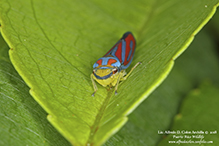 |
|
Deb |
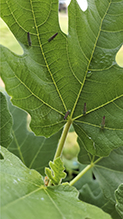 |
Tami |
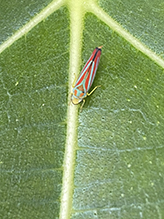 |
Scott Bemman |
 |
Troy |
 |
C Wysocki |
 |
On swamp milkweed |
MinnesotaSeasons.com Photos |
||
|
||
|
||

Visitor Videos |
||
Share your video of this insect. |
||
This button not working for you? |
||
|
Other Videos |
||
Red-banded Leafhoppers (Cicadellidae: Graphocephala coccinea) Making Honeydew |
About
Published on Jul 6, 2010 Photographed at the Turtle River State Park, North Dakota (06 July 2010). |
Candy-Striped Leafhopper (Graphocephala coccinea) |
About
Published on Sep 8, 2017 The Candy-Striped Leafhopper (Graphocephala coccinea) has bright Red and Blue stripes with a Yellow head and legs. Music: Hyperfun by Kevin MacLeod is licensed under a Creative Commons Attribution license (https://creativecommons.org/licenses/by/4.0/) Source: https://incompetech.com/music/royalty-free/index.html?isrc=USUAN1400038 Artist: http://incompetech.com/ |
Red-banded Leafhopper - Graphocephala coccinea |
About
Published on Sep 11, 2010 I don't understand the coloring for survival around here. I left the background noise because I learned my nephew does the same thing to my sister so I feel a rant coming on. If I rant you will know what it's about. |
graphocephala coccinea |
About
Published on Jul 21, 2018 |
Red-banded Leafhoppers (Cicadellidae: Graphocephala coccinea) Feeding |
About
Published on Jul 6, 2010 "In every walk with nature one receives far more than he seeks." --John Muir Photographed at the Turtle River State Park, North Dakota (06 July 2010). |

Visitor Sightings |
||
Report a sighting of this insect. |
||
This button not working for you? |
||
Lane Keller |
Location: Itasca State Park I found this beautiful little leafhopper not far from the Camping/Lodging Office on a small tree. |
 |
| Jaclyn B. 7/10/2023 |
Location: Moorhead, MN on a dahlia leaf |
 |
| Alfredo Colon 8/20/2022 |
Location: Albany, NY |
 |
| Alfredo Colon 8/2/2022 |
Location: Albany, NY |
 |
| Deb 7/11/2021 |
Location: Side Lake, MN |
 |
| Tami 7/4/2021 |
Location: Stratford CT |
 |
| Scott Bemman 7/26/2020 |
Location: Scenic State Park |
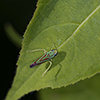 |
| Troy 7/10/2020 |
Location: Circle Pines, MN |
 |
| Alfredo Colon 8/7/2019 |
Location: Woodbury, Minnesota |
 |
| C Wysocki 7/10/2019 |
Location: Plymouth, MN On swamp milkweed |
 |
| Alfredo Colon 8/20/2018 |
Location: Woodbury, Minnesota |
 |
| Alfredo Colon 6/10/2018 |
Location: Woodbury, Minnesota |
 |
MinnesotaSeasons.com Sightings |
||
|

Created: 12/9/2018 Last Updated: © MinnesotaSeasons.com. All rights reserved. |
